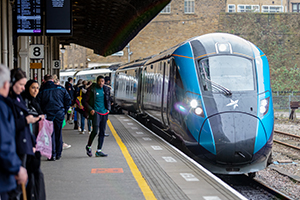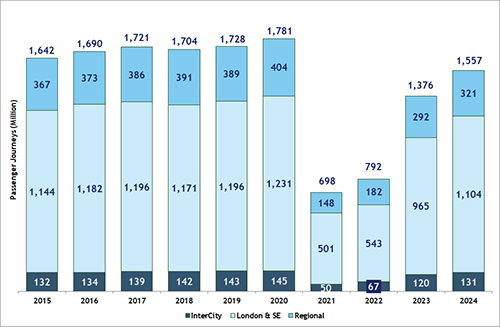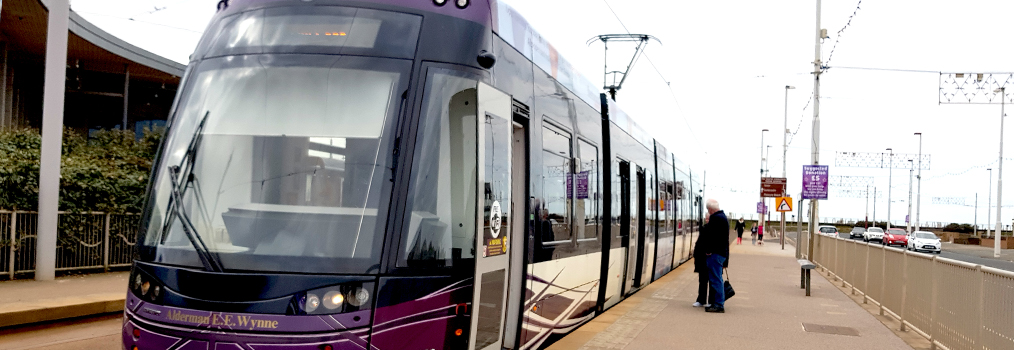Rail demand growth slows over the winter
Booming markets on London concessions flatter national totals
The recovery in demand for rail services in Britain from the Covid pandemic continued into the winter quarter this year, but at the slowest pace since the end of the pandemic. Overall, demand rose to 91.9% of pre-Covid levels, according to National Rail Trends statistics, published by the Office of Rail and Road (ORR). However, without the Elizabeth Line, the recovery is limited to 81.9%.

The provisional figures cover the fourth quarter of fiscal year 2023/24, finishing at the end of March: across the network, 405.5m passenger journeys were made during the twelve-week period, up from 359.1m in 2023. Between them, they covered 15.0 billion passenger kilometres, 9.3% up, and paid a total of £2,581.1m in fares, 17.2% more than in 2022.
Looking at demand by ticket type, advance tickets were up by 23.2%, taking sales 60% higher than before the pandemic. Anytime peak and off-peak fares were up by 12.4 and 15.1% respectively, leaving them 19.5% and 26.7% ahead of the pre-Covid figure. Season ticket holders made 2.7% more journeys than last year, but the 60.32 million total remained 64.5% below the 2019 figure.
Excluding the Elizabeth Line, services in London and South East moved ahead by 10.2% during the quarter, but this meant that it was the slowest growing sector. Between them, the operators carried 230.1m passengers in the twelve weeks, but remained 22.1% below 2019. Double digit growth was the norm for the sector, with strongest quarterly growth coming at Greater Anglia (14.4%), followed by West Midlands (12.8%) and South Eastern (12.4%). The exception was c2c (1.8%).
The Elizabeth Line carried 55.4 million passengers in its seventh full quarter of operation, 24.3% up in the year, meaning that the line accounted for 13.7% of the national network’s patronage in the January to March quarter, second only to GTR’s 17.4%.
The long-distance InterCity sector saw demand increase by 13.3% compared with 2022, leaving passenger numbers just 3.8% short of 2019 levels. Cross Country saw the largest growth, on 26.3%, 13.7% below pre-pandemic levels. They were followed by Avanti West Coast on 22.2%, but still 15.6% down from 2019. EMR grew by 12.2%, taking passenger numbers 13.2% above pre-pandemic levels. Caledonian Sleeper saw growth of 16.2%, but was still 11.1% short of previous highs. GWR advanced by 7.9% to 82.9% of pre-Covid patronage, handicapped in part by the loss of Thames Valley suburban passengers to the Elizabeth Line since 2022. LNER was the only TOC to record a drop in passenger numbers, down 2.5% on the quarter, though the business still remained 8.2% ahead of its 2019 numbers.
Amongst the regional franchises, total patronage was 14% up on 2022 but remained 13.4% below 2019 levels. Amongst individual TOCs, TransPennine saw the strongest recovery, growing passenger numbers by 38.2% during the quarter, reducing the shortfall against their 2019 figure to 17.0%. TfW saw growth of 26.7% on the quarter and moved to within 15.4% of its 2019 figures. Scotrail grew by 17.9%, 16.5% short of pre-Covid levels. Merseyrail saw growth of 12.5% but demand remained over 30% down on 2019. Northern saw a rise of just 1.9% in passenger journeys, leaving a shortfall of 15.2%.
Amongst the non-franchised operators, Hull Trains saw growth of 9.2% and exceeded their 2019 number by 33.2%. East Coast rivals Grand Central grew numbers by just 3.9% and moved to 15.0% ahead of their pre-Covid patronage. Still suffering from competition from the Elizabeth Line, Heathrow Express saw numbers slip by 12.4% in the quarter. This left patronage on the premium route almost a third down on previous peaks. Lumo grew by just 0.7% during the quarter.
Rolling year figures
The national totals for the twelve months ended 31 March show that, compared with the last pre-Covid year of 2018/19, the number of passenger journeys was 8% lower at 1,611.9 million. However, excluding the Elizabeth Line, passenger numbers remained 18.2% short of the 2019 figure. Passenger kilometres travelled were 13.5% lower at 58.6 billion, whilst passenger revenue saw a shortfall of 12.9% at £9,527.6 million.
As in previous quarters, performance varied between the sectors. Passenger journeys were still 19.4% below 2019 levels in London and South East but moved to within 8.5% on the regional networks and 9.7% on the InterCity routes.
Comment
The winter months saw the rail industry maintain its progress towards recovery from Covid, albeit at a slower rate than previously in what is traditionally the quietest quarter of the year. Overall numbers are now almost 92% of the figure in the same quarter in 2018/19. That is a good headline, but as so often before, it more disguises a much more nuanced picture, where a major driver of growth is a combination of TfL concessions and open access operators.
The economic backdrop was hardly encouraging, either – with continuing high interest rates and reduced consumer spending accompanying very weak economic growth – hardly the background to a boom in demand for transport.
The Elizabeth Line continues to go from strength to strength – such that a need for more rolling stock has this month resulted in a life-saving order for Alstom’s Derby factory. Patronage grew by almost a quarter during the spring to reach 55.4m, giving the line an annual total of 220 million, 10 per cent above the original forecast. London Overground saw growth of 7.3% during the January-March period, bringing the total to 44.6m, just 5.2% below the pre-pandemic figure. On an annual basis, the suburban and orbital routes carried 181.4m journeys – within 3.6% of the 188.1m figure reached before Covid. Between them, the two TfL concessions accounted for 24.9% of national patronage during 2023/24 compared with just 13.6% in 2018/19.
The three long distance open access operators saw growth of 4.6% during the quarter – pretty good for the winter when optional travel tends to be depressed. Hull Trains and Grand Central are now both well ahead of their previous peaks in 2018/19 – with the former carrying a third more passengers and the latter 15 per cent.
The remaining 18 TOCs fall within the DfT’s remit, and here the position is rather less healthy, with patronage still below 80% of pre-pandemic levels. As in previous quarters, the problem continues to lie primarily with a lack of commuters. As a result, the London commuter lines are still behind in the recovery stakes, having a shortfall of 22%. At 10.2%, the growth seen during the autumn quarter was well behind that achieved on the long distance and regional routes.
The regional networks also received a boost in the quarter, the 14% growth taking them to 83.7m journeys, 13.4% short of the same quarter in 2018/19. Inflation-adjusted revenue remained 18% down, however, and yields were 13.2% down.
The long distance InterCity routes achieved over 96% of previous levels during the twelve weeks and saw demand up by 13% over the same quarter in 2023. But revenue remains a problem: after adjusting for inflation, these routes had a revenue shortfall of over 24%, and inflation-adjusted yields (revenue per passenger kilometre) are still 17% lower than pre-Covid.
In London and the South East, revenue recovery is slightly better than patronage – at 80.0% against patronage of 79.4%. A shift from season ticket purchase to full fare or off-peak tickets continues to help here. Yields rose by 0.6% and are just 3.8% down from 2019.
The shift in the type of tickets purchased continues – and here the latest figures confirm several trends that we have noticed before. First the move towards advance purchase tickets – passengers using these increased by almost a quarter during the three months, taking the numbers to a touch under 60% higher than pre-Covid. Anytime/peak tickets saw passenger numbers up by 12.4%, so that sales were 19.5% higher than 2019, whilst off-peak fares were used by 15.1% more people, now 26.7% up on pre-pandemic. Journeys undertaken by season ticket holders remain in the doldrums. There was growth of 2.7% in the quarter, but the total is still more than 64% down on previous levels.
The patronage shortfall remains a problem – but recovery is still continuing, and would no doubt be helped by an end to strikes and disruptions caused by staff shortages and overtime bans – confirmed by a continuing performance recovery at Avanti West Coast and TransPennine being reflected in patronage growth as well. ORR reports strikes on some part of the network on six days during the quarter.
As time moves on from the pandemic, some – including the ORR itself in its latest bulletin – are arguing that it is time to put aside the constant referral back to the halcyon days of 2018/19 and focus instead on year-on-year comparisons. It is certainly clear that some of the changes induced by the pandemic – especially working from home – are now permanent. Recent new figures from the Office for National Statistics seem to show that working habits – including working from home on some or all days in the week – have remained very similar for the last two years.
Once can see the argument, but on the other hand the 2018/19 figures remain a high watermark for the industry in terms of both patronage and revenue, and as such will remain a useful baseline for some time to come – and a good excuse for celebration if and when that record is broken.
Click to view Quarterly Rail Stats - 31 March 2024. Click also for Passenger Journeys by Operator - 31 March 2024.
Rail Passenger Journeys by Sector, Year to 31 March 2024




